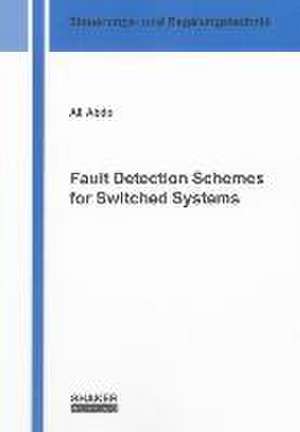Fault Detection Schemes for Switched Systems: BERICHTE AUS DER STEUERUNGS- UND REGELUNGSTECHNIK
Autor Ali Abdoen Limba Engleză Paperback – 5 oct 2013
Din seria BERICHTE AUS DER STEUERUNGS- UND REGELUNGSTECHNIK
-
 Preț: 87.58 lei
Preț: 87.58 lei -
 Preț: 80.84 lei
Preț: 80.84 lei -
 Preț: 266.56 lei
Preț: 266.56 lei -
 Preț: 261.52 lei
Preț: 261.52 lei -
 Preț: 265.56 lei
Preț: 265.56 lei -
 Preț: 244.70 lei
Preț: 244.70 lei -
 Preț: 260.73 lei
Preț: 260.73 lei -
 Preț: 243.76 lei
Preț: 243.76 lei -
 Preț: 291.15 lei
Preț: 291.15 lei -
 Preț: 243.61 lei
Preț: 243.61 lei -
 Preț: 218.65 lei
Preț: 218.65 lei -
 Preț: 271.16 lei
Preț: 271.16 lei -
 Preț: 270.50 lei
Preț: 270.50 lei -
 Preț: 270.94 lei
Preț: 270.94 lei -
 Preț: 262.91 lei
Preț: 262.91 lei -
 Preț: 260.95 lei
Preț: 260.95 lei -
 Preț: 245.65 lei
Preț: 245.65 lei -
 Preț: 288.66 lei
Preț: 288.66 lei -
 Preț: 214.74 lei
Preț: 214.74 lei -
 Preț: 272.11 lei
Preț: 272.11 lei -
 Preț: 257.33 lei
Preț: 257.33 lei -
 Preț: 260.80 lei
Preț: 260.80 lei -
 Preț: 262.40 lei
Preț: 262.40 lei -
 Preț: 242.31 lei
Preț: 242.31 lei -
 Preț: 241.00 lei
Preț: 241.00 lei -
 Preț: 242.81 lei
Preț: 242.81 lei -
 Preț: 200.04 lei
Preț: 200.04 lei
Preț: 260.04 lei
Nou
Puncte Express: 390
Preț estimativ în valută:
49.76€ • 51.85$ • 41.20£
49.76€ • 51.85$ • 41.20£
Carte indisponibilă temporar
Doresc să fiu notificat când acest titlu va fi disponibil:
Se trimite...
Preluare comenzi: 021 569.72.76
Specificații
ISBN-13: 9783844022346
ISBN-10: 3844022341
Pagini: 134
Ilustrații: 25 farbige Abbildungen
Dimensiuni: 146 x 211 x 15 mm
Greutate: 0.2 kg
Editura: Shaker Verlag
Seria BERICHTE AUS DER STEUERUNGS- UND REGELUNGSTECHNIK
ISBN-10: 3844022341
Pagini: 134
Ilustrații: 25 farbige Abbildungen
Dimensiuni: 146 x 211 x 15 mm
Greutate: 0.2 kg
Editura: Shaker Verlag
Seria BERICHTE AUS DER STEUERUNGS- UND REGELUNGSTECHNIK
